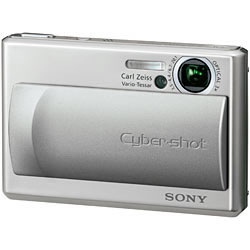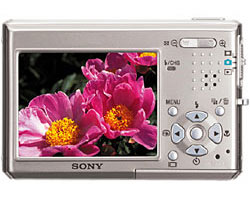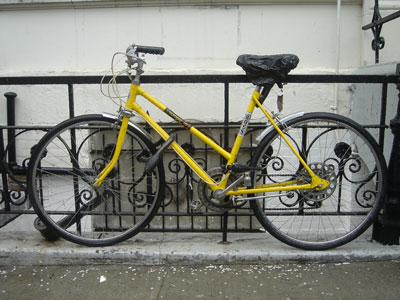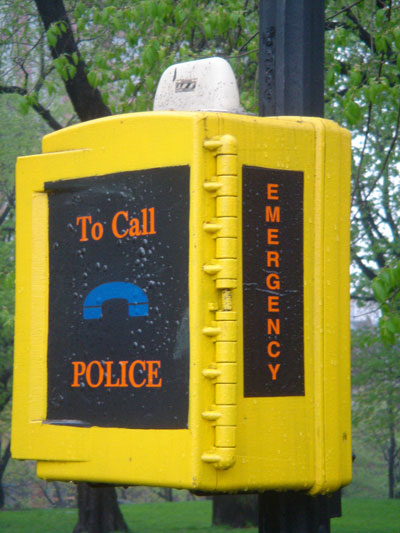Sony Cyber-Shot DSC-T1: Digital Camera with Big Resolution, Small Dimensions

Buying a digital camera always requires trade-offs, but increasingly, there are fewer and fewer compromises that you have to make when selecting a camera that’s right for you. The new Sony Cyber-shot DSC-T1 5-megapixel camera is one of the best examples of this phenomenon.
Until recently, if you wanted a very small camera that could be easily carried in a shirt pocket, you had to sacrifice resolution, features, and overall image quality. The T1, remarkably, doesn’t compromise on any of these fronts. It’s not perfect — we wouldn’t mind some manual shooting modes and a tripod mount — but it’s hard not to be impressed by the camera’s tiny size and excellent image quality.
Is That a Camera in Your Pocket?
The T1 is a very attractive camera, with an all-metal body, and beautiful silver finish (see Figure 1). Measuring 3 5/8 x 2 3/8 x 7/32 inches (91 x 60 x 21mm), and weighing 7 ounces (200 grams) the T1 feels sturdy and solid, with excellent all-around build quality. It’s a camera that you want to hold.

Figure 1: Sony’s compact DSC-T1 features a lens that remains tucked inside the body, protected by a sliding panel.
Like most small digital cameras, the T1 has a 3X optical zoom, but while most cameras feature a zoom lens that extends outward from the front of the camera’s body (usually extending and retracting as you turn the camera on and off), the T1 packs the entire zoom mechanism vertically inside the camera. This makes the camera feel much smaller than competing tiny cams, like the Canon Digital Elph series. It also means that you don’t have to wait for the lens to extend when you turn the camera on.
A metal door runs the width of the front of the camera and slides easily up and down to expose the lens and power up the camera. Though there’s no wait for the lens to extend, the camera still needs roughly a second to boot up, a commendably short time that shouldn’t cause you to miss any shots.
After its small size, the most notable feature of the camera is the 2.5-inch LCD screen that covers most of the back of the camera (see Figure 2). Two and a half inches is large for any LCD screen, but on a camera this small it seems positively huge. The T1 lacks any type of optical viewfinder, so Sony has chosen an extremely high-quality trans-reflective LCD screen that is bright and clear, even in direct sunlight. On many digital cameras, the lack of optical viewfinder would be a deal-breaker, but because the T1’s LCD screen is visible under just about any lighting condition, you shouldn’t feel hampered by the camera’s LCD-only design.

Figure 2: The T1’s LCD is bright, clear, and huge for a camera of this size.
There are other cameras with the T1’s proportions, such as the Casio EX-Z4U (which is actually a hair smaller) but none offer the T1’s built-in lens design and giant LCD screen, let alone 5-megapixel image quality. For the moment, the T1’s design is unique.
Buttons and Switches and Dials, Oh My!
The interface of the DSC-T1is simple and well configured. A simple slider switch on the side lets you select between record, playback, and movie modes. Though we prefer a camera with shooting priority — that is, one that automatically switches to shooting mode with a slight press of the shutter button — the T1’s mode changes are fast enough that you shouldn’t be handcuffed by it.
The rest of the camera’s interface is controlled with a simple set of buttons on the back of the camera. The camera’s zoom control is also located on its back and is easily reached with your thumb.
Our biggest complaint with the T1’s design is the location of the shutter release button. Sony has planted the button in the traditional camera location: the extreme right side of the camera’s top. Unfortunately, because the T1 is so small, the shutter button’s position requires you to cramp up your hand somewhat, particularly if you have large hands (see Figure 2). The camera would be more comfortable if the button were placed more towards the middle of the camera.
Oddly enough, the T1 feels slightly difficult to use one-handed because of its small size. With one hand, you have to be careful that your thumb does not press any of the controls on the back of the camera, and trying to hold the camera securely while zooming can be tricky. You’ll definitely want to install the wrist strap if you plan on using the camera one-handed.
Two-handed use feels more secure, but because the lens is flush with the left side of the camera, you have to be very careful not to block the lens with your left hand. Fortunately, the lens is so small that it’s easy enough to re-position your hand in a more comfortable position.
The camera’s menu system is intuitive and speedy to respond, which is good because other than flash, self-timer, macro, and resolution modes, you have to enter the menus to change all other options and features. We would have liked to see an external exposure compensation control.
The camera uses a proprietary Sony InfoLithium battery that slides into the bottom of the camera. Oddly enough, it is possible to insert the battery upside down, but doing so does not hurt the camera. As with all Sony batteries, battery life is very good, and the T1 should manage 100-150 pictures on a single charge. This may sound small when compared to other cameras, but bear in mind that the T1’s battery is physically very tiny.
Unfortunately, Sony continues to try to cram their proprietary MemoryStick technology into the world. The T1 uses the smaller MemoryStick Duo format, which is about half the length of a normal MemoryStick card. The Duo card comes with an adapter that allows it to fit into a normal-sized MemoryStick slot, so you can use the card with other MemoryStick devices.
There’s nothing technically wrong with MemoryStick technology, but the fact that it’s only used in Sony devices means it will never become as widespread as other technologies such as XD Picture Card or CompactFlash. As such, MemoryStick memory capacities and prices still lag behind competing technologies. What’s more, if you already have a camera that uses a different format, you’ll have to invest in a whole new set of memory cards.
Shoot the Moon
The T1 is a speedy little camera with very low shutter lag and a burst mode that can manage about 4 frames per second. Images write to the card very quickly, so the camera is almost always ready to shoot.
Image quality is extremely good, offering excellent sharpness and color reproduction. You’ll notice a little vignetting, barrel distortion, and softness around the corners when shooting at full wide, but these effects are slight (see Figure 3).

Figure 3: The T1 sports a very high-quality lens that delivers very good sharpness and fine color reproduction.
The camera delivers images with very low noise at ISO 100,m it’s slowest speed. The camera also provides 200 and 400 ISO settings, which are noticeably noisier. It’s not a terribly chromatic noise, however, and is fairly fine-grained, so it’s not distracting (see Figure 4).


Figure 4: At ISO 400, the camera suffers from noise, but the effect is not terribly ugly.
Automatic mode is your only option on the T1; there are no priority or manual modes, although Sony has provided pre-set Scene modes (Landscape, Sand, and Snow, Slow-sync Shutter, etc.) that can suffice for most tricky situations (see Figure 5). Other small cameras offer a little more manual control, and we would have liked at least some priority modes on the T1.

Figure 5: Although the T1 lacks manual exposure modes, its automatic exposure does a good job, capturing a decent shot in this heavily shadowed scene.
Shooting-wise, the camera’s flash performance is its weakest point. The camera’s teeny flash is too small to illuminate even a mid-sized room. It’s really only suitable for closer shots of individuals or small groups of people.
Given the physically small size of the flash, there’s not really much that Sony can do about this. However, there’s no excuse for the camera’s terrible red-eye problem. Because Sony positioned the flash directly next to the lens, red-eye is inevitable. With all the space on the front of the camera, it’s strange that they didn’t try to move it farther to the other side. Unfortunately, the flash’s lens is so weak that its red-eye reduction flash is not very effective, even at close range.
In addition to its overall image quality, the camera’s most impressive shooting feature is, oddly enough, its video capability. The T1 can shoot 640-x-480-pixel video, with sound, at 18 frames per second. Eighteen frames per second is actually all you need to achieve video with synchronized sound, and the T1’s MPEG-4 video quality is almost indistinguishable from DV video. If you invest in the more expensive MemoryStick Duo Pro format, you can shoot video at 30 frames per second. Recording length is limited only by the amount of storage you have available, but you should be able to shoot several minutes on a good-sized card. You can’t zoom while shooting, but for small clips, this capability is amazing in any camera, let alone one this small.
If you drop the video to its lowest quality (160-x-120 pixel) you can fit a couple of hours onto a 512mb card. Because this mode still records full-quality audio, the T1 can serve as a very capable voice recorder.
Hit the Pocket
Sony has done an excellent job with the T1. It is truly a no-compromise answer if you’re looking for a small camera. Flash photography will be the camera’s weakest point, and though there are some other minor changes we’d like to see, for a point-and-shoot that’s easy to carry, these problems are pretty insignificant.
The camera’s beautiful design and small size will be its major appeal, but the very good image quality is why you’ll continue to use it.
Read more by Ben Long.
This article was last modified on January 18, 2023
This article was first published on April 27, 2004




